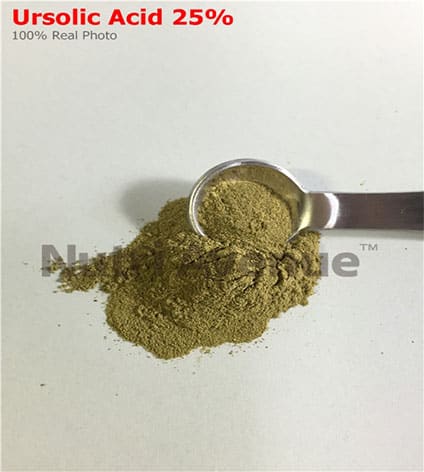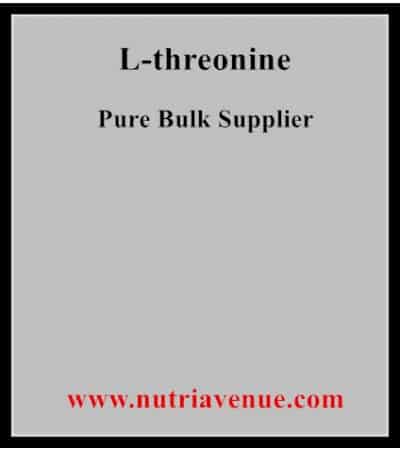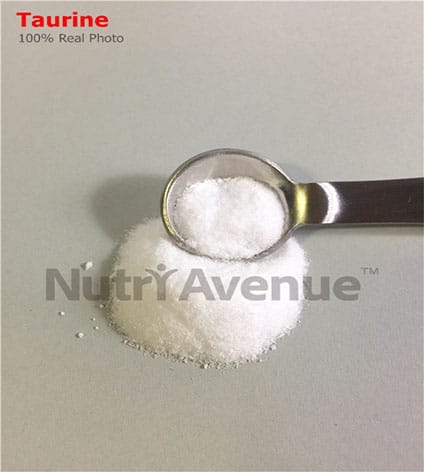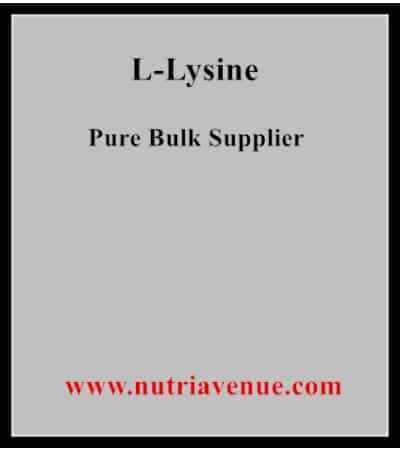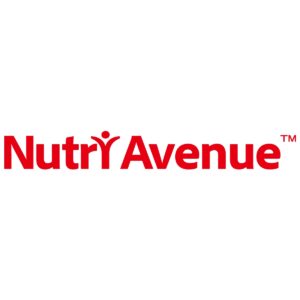Ursolic Acid
The ursolic acid powder is widely used in the health supplement industry for its remarkable effect in preventing many conditions associated with degeneration of the brain cells. Studies also suggest that the compound may be useful in promoting weight loss, as well as in increasing muscle mass.
What is Ursolic Acid?
Ursolic Acid was first discovered in apple waxes in the early 1920s. It is an active compound found in many herbs and plants. Its molecular formula is C30H48O3 and its CAS Number is 77-52-1. The molecular weight of Ursolic Acid is 456.71 g/mol. Based on modern science, the compound can be useful among elderly individuals who are diagnosed with dementia and Alzheimer’s disease, as well as middle-aged adults who are at high risk for developing the said brain conditions.

Ursolic Acid Solubility
Generally, ursolic acid is mostly soluble in organic solvents and sparingly soluble in aqueous buffers. Hence, it may be dissolved in ethanol or dimethylformamide (DMF). When using aqueous buffers, researchers suggest that ursolic acid should first be dissolved in DMSO.
The compound is generally not soluble in water.
Source: https://www.caymanchem.com/pdfs/10072.pdf
Ursolic Acid vs. Tomatidine
Health studies suggest that both Ursolic Acid and Tomatidine may be very useful in preventing muscle atrophy and promoting the development of muscle mass. While Ursolic acid is typically derived from apple peelings and other herbs, Tomatidine is mostly found in unripe tomatoes.
Both Ursolic Acid and Tomatidine are also believed to be beneficial in preventing neural degeneration. According to experts, Ursolic acid works to protect neurons by enhancing the production of oligodendrocytes and suppressing Th17 immune cells. On the other hand, Tomatidine prevents brain cell damage by inhibiting the production of acetylcholinesterase or an enzyme that destroys the neurotransmitter acetylcholine.
Ursolic Acid Food Sources
The pentacyclic triterpene acid Ursolic Acid can be taken from various fruits and vegetable sources. It is can be found in bilberries, cranberries, and prunes. Common herbs such as oregano, thyme, and basil also contain relative amounts of Ursolic Acid. For commercial bulk ursolic acid supplements, the compound is mostly sourced from Rosemary leaf extract, Paulownia Tomentosa Extract, Holy Basil leaf extract, and apple peel.
Rosemary Leaf Extract
Rosemary leaves are among the most common sources of many bioactive compounds known to enhance human health. Among the triterpenes found in rosemary leaves is Ursolic Acid. The anticancer and anti-inflammatory effect of Rosemary, as presented in health studies, is believed to be associated with its Ursolic Acid content, among other compounds.

Paulownia Tomentosa Extract 25% Ursolic Acid
One of the most interesting researches on Paulownia Tomentosa Extract which is very promising for cancer patients is the finding that it may help prevent liver damage brought about by chemotherapy. This is said to be associated with its Ursolic Acid content. According to experts, Paulownia Tomentosa Extract 25% Ursolic Acid may also be quite beneficial in preventing hepatocarcinogenesis as well as hepatitis.
Holy Basil Leaf Extract 2.5% Ursolic Acid
Among the important compounds found in Holy basil leaf extract which is believed to be beneficial in promoting health and wellness is Ursolic Acid. The effect of holy basil in preventing skin cancer, as presented in certain health studies, is believed to be linked to its Ursolic Acid content. Many experts also say that Ursolic Acid in Holy basil leaves has potent anti-inflammatory effects. The therapeutic dosing range for ursolic acid in the standardized extract is >2.5%, 200 to 500 mg daily.
Apple Peel
As it was first discovered in apple peels, health practitioners say that Ursolic Acid is widely related to the health benefits of using apple peels. In a study conducted on mice subjects, it was found that Ursolic Acid in apple peels can help prevent obesity. It was also observed in the same study that the subjects, compared to the control variable, developed more muscle mass.

Ursolic Acid Specifications
Typically, the purity of Ursolic Acid is at 25%. Thus, it is believed to be most effective in this quantity.
There are several forms in which Ursolic Acid may be introduced to the body for supplementation. The most common form is through capsules and tablets.
Many experts say that Ursolic Acid supplementation through capsules is ideal because it is fast-acting and it provides a higher drug absorption rate. Hence, the best way to supplement Ursolic Acid, according to experts, is through capsule forms. However, supplementation through capsules may be less durable with shorter shelf life.
Ursolic Acid supplementation through tablets, on the other hand, is beneficial durable and long-lasting, chewable, and inexpensive. The cons of using tablet forms, however, are that it is slow acting and may cause a little irritation in the gastrointestinal tract.
Since the compound cannot be dissolved in water, it does not usually come in powder forms when it comes to supplementation.
Ursolic Acid Supplement
The internet offers a wide range of choices for ursolic acid supplements. This is because there are various types of research providing evidence on the potential health benefits of using the compound. However, it is important to remember to purchase Ursolic Acid Supplement only from reputable suppliers.
Ursolic Acid Benefits
-
Ursolic Acid for bodybuilding
Individuals who are into bodybuilding know very well how efficient Ursolic Acid is in promoting weight loss and enhancing muscle development. Also, the compound can be useful in promoting bone growth and controlling inflammation, thereby improving bodybuilding efforts.

-
Ursolic Acid for lean muscles
A wide range of studies reveals that Ursolic Acid is quite beneficial in both men and women when it comes to lean muscle mass development. It is believed that the compound effectively reduces markers indicative of muscle damage. Furthermore, experts say that the compound may improve muscle strength, especially among men.
-
Ursolic Acid for weight loss
Fat loss is one of the reasons why many advocates of health supplement products promote the use of Ursolic Acid. According to research, the compound can help lower Body Mass Index (BMI) by inducing the fat-burning process of the body. It is also said that the compound may reduce waist circumference.
-
Ursolic Acid for cardiovascular health
One study conducted on mice subjects has revealed that Ursolic Acid may help improve cardiovascular health in many pathways. It is believed that the compound may effectively reduce heart rate among users. It may also prevent pressure in the heart by preventing fluid retention through diuretic effects.
Some experts also say that Ursolic Acid may promote the production of certain enzymes necessary for heart health and prevent damage to cellular DNA.
-
Ursolic Acid for psoriasis
The phytochemical Ursolic Acid, as presented by health experts, is also found to be useful in treating certain skin illnesses. In a new study, experts have found that the compound helps suppress Interleukin-17 or IL-17, thereby establishing a clearer understanding as to how it may be used to treat psoriasis and other autoimmune inflammatory health conditions.
Ursolic Acid Dosage
The recommended dosage for Ursolic Acid use depends on several factors including the purpose for its use, the current health status of the individual user, as well as age. For healthy adults, the recommended dosage for the said compound is usually 150 mg, taken three times a day. Hence, the total daily dosage is usually 450mg.
It is important for individuals who are suffering from certain health conditions to consult a physician before using the compound for health supplementation purposes. This is also intended to prevent drug interactions among persons who are taking medications for various disorders.

Ursolic Acid Side Effects
When taken within recommended dosages, Ursolic Acid does not usually cause side effects. However, some individual users have reported incidents of nausea and vomiting as well as skin rashes following Ursolic Acid use. These side effects typically disappear in time.
Individuals who are experiencing side effects of ursolic acid use for long periods are advised to consult a physician.
Where to Buy Ursolic Acid Powder in Bulk Quantity?
Choosing where to buy ursolic acid powder in bulk should depend not only on the prices offered by suppliers but more importantly, the reputation of the given supplier. For bulk Ursolic Acid powder, Nutriavenue.com is one of the most trustworthy and affordable sources. Nutriavenue.com is registered with the Food and Drug Administration (FDA) as an ingredient supplier. The factories of the company are likewise certified by the FDA, Kosher, Halal, and GMP.
Conclusion
The best way to protect health and wellness effectively is through the supplementation of beneficial compounds like Ursolic Acid. It is useful not only for athletes and bodybuilders but also for adults who seek to improve their overall health and wellness.

